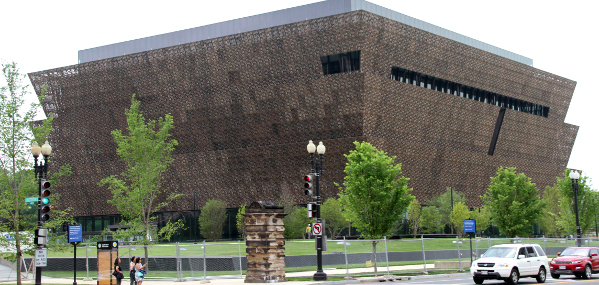Why the New African-American Museum in D.C. Is a Must-See on Your Next Trip

The new African-American Museum in D.C. nears completion in June 2016. Photo by Tony Hisgett/Flickr
Lonnie Bunch III grew up wanting to know more about his African-American culture — more than the stories of slavery and well-known heroes like George Washington Carver.
But there wasn’t a museum dedicated to African-American history where he could learn those lessons . . . until now.
“This museum will tell the American story through the lens of African-American history and culture,” said Bunch, who is the founding director of the National Museum of African American History and Culture. “This is America’s story and this museum is for all Americans.”
The museum opened on the National Mall in Washington, D.C. on Sept. 24, 2016.
“History, for me, became a tool to help me understand my own life,” Bunch told the Christian Science Monitor shortly before the museum opened. “But I also realized that if a nation understands its history, it is a wonderful tool to help a nation figure out how they live their lives, how to understand the conditions they face.”
Like Bunch, educators love to use history as a tool to help students understand themselves, their culture and their country better. That’s one reason to predict the new African-American museum in D.C. quickly will become a can’t-miss stop on educational tours and field trips.
Washington now has 17 Smithsonian museums, plus others dedicated to the Holocaust, media, art and more. But the NMAAHC provides the first large-scale opportunity to study African-American history from its origins in slavery to the modern Black Lives Matter movement.
If you’re wondering whether the museum will be worth a visit, you don’t have much company — whenever the museum has made its advance (free) timed-entry passes available, they have been claimed nearly instantaneously. (To learn more about getting passes, get the latest from the official museum site or talk to your tour operator — the way companies like Julian Tours obtains group tickets is slightly different than the general public).
On the off chance that we need to make a case for visiting, here are three reasons you’ll want to take your class or group to the NMAAHC:
To Understand the Fight for Rights
Students will have an opportunity to see how their ancestors won rights now taken for granted through centuries of struggle.
That lesson will be taught with the help of 3,000 objects in 12 galleries, ranging from a slave cabin to the pen that President Lyndon B. Johnson used to sign the 1965 Voting Rights Act to 10 shards of stained glass from the 16th Street Baptist Church bombing.
(Beyond those 3,000 objects, the museum has 34,000 additional items in reserve for research and future exhibits!)
To Appreciate the Scope and Power of Black Culture
Students will see how today’s culture was shaped by past generations.
Some exhibits at the new African-American museum will help them understand how today’s music scene came out of Motown, soul, blues and jazz.
Others show how present-day athletes benefited from trailblazing by the likes of Muhammad Ali, Carl Lewis and Jackie Robinson.
African-American giants in literature, theater, dance and more are featured, as well.
To Inspire as Well as Educate
The NMAAHC deals with weighty topics. But it is not a museum “of crime or guilt or holocaust,” Bunch said.
He met with officials from the nearby Holocaust museum and those from the 9/11 Museum in New York to get tips on balancing education with enlightenment. Yes, the museum tour starts with a Portuguese slave ship that sank off South Africa and moves to a South Carolina slave cabin and then a child’s shackles. But it eventually continues to the birth of modern hip-hop music and Chuck Berry’s red Cadillac.
“You couldn’t tell the story of the African-American experience without wrestling with difficult issues, without creating those moments where people have to ponder the pain of slavery, segregation or racial violence,” Bunch said.
The museum in the shadow of the Washington Monument is meant to teach children and adults that the ills of history needn’t be repeated if lessons are carried into the future. That history is not meant to bear sadness, but inspire hope for a better future.
Julian Tours has produced a free, downloadable guide for educators and others planning a group visit to the new National Museum of African American History and Culture in Washington, D.C. Click below for more information:





